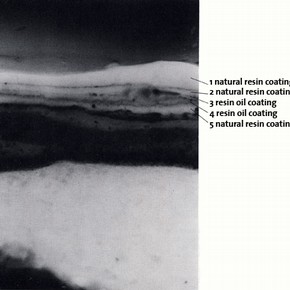Conservation Journal
January 1992 Issue 02
Introducing ‘new methods in cleaning objects’ to the V&A
In August 1990 I was fortunate to attend a workshop on 'New Methods in Cleaning Paintings' held at the Getty Conservation Institute in Los Angeles. The workshop was lead by Professor Richard Wolbers of Winterthur Museum and the University of Delaware.
Wolbers has applied his training as a biochemist to the problems of cleaning painted surfaces. Specifically, he has used his expertise to develop the analysis and interpretation of the layered structure of painted surfaces with a view to cleaning.
Using biochemical staining techniques and ultra violet autofluorescence to identify varnish layers, (see illustration), and components such as natural resins, drying oils and proteinaceous materials, cleaning can be approached in an altogether more accurate and accountable way.
Once the identification of the materials to be cleaned has been made, it should be possible to formulate a cleaning method which is tailor-made to a particular problem.
Wolbers introduced methods of gelling solvents. In a solvent gel the rate of evaporation is reduced and the flow is restricted. This has the advantage that less polar solvents can be applied to the surface. The risk of swelling a vulnerable oil paint is reduced and health and safety aspects for the conservator are considerably improved.
Emulsions offer the potential of combining the characteristics of two or more solvents which would otherwise be immiscible and incorporate water as a polar solvent into the cleaning mix.
Resin soaps constructed specifically to clean pure resin varnish layers are phenomena new to conservation cleaning techniques. In theory it is possible to manufacture a soap from any resinous material and use that soap to clean a resin varnish - since 'like dissolves like'. In practice however, this can be expensive and impracticable.
Wolbers began looking at the structures of some of the 30,000 or more soaps that are available commercially and compared the stereochemical structures of resins used in varnishes with soaps made from resins. Two types of resin soap in particular displayed structures similar to resin varnishes. Deoxycholic resin acid derived from bile acid, and abietic resin acid originating from fir trees, have characteristics comparable to those of natural resin varnishes. These two soaps have proved capable of removing such varnishes.
Enzymes used to break down specific oil or proteins, such as animal glues, are not new to conservation generally, but have never been considered for the cleaning of easel paintings. They can be applied very specifically, for example where an oiling out layer exists between two varnish layers, and can aid the conservator during cleaning.

UV autofluorescence of cross section revealing 5 layers of varnish with oil/grime layers in between (click image for larger version)
It was possible to take cross sections to the Getty workshop from a painting in the V&A collection. The cross sections taken by Josephine Darrah of the V&A Science Section provided an exemplary illustration for the potential of the 'New Methods'.
Two workshops for conservators at the V&A have resulted from this work as well as opportunities to present papers at two courses run by Wolbers at the Sorbonne in June and the Rijksdienst Beeldende Kunst in The Hague in November.
The Conservation Department at the V&A covers most disciplines and conservators have been keen to learn and develop the new methods. The scope for development at the V&A is enormous and interdisciplinary communication should prove an asset to such development. Conservators from Textiles, Furniture, Ceramics, Sculpture and Metalwork have made solvent gels to apply and test in their studios along with resin soaps. Further workshops are planned for the New Year.
It was interesting to observe the differences in the way the courses were organized. Both GCI and Paris invited conservators from across the world, which is very good for 'networking'. The problem which arises from this kind of global approach is that individual conservators find themselves working in isolation when they return home.
It is essential to maintain contacts with conservators practising the new methods. In Holland the course was organized for Dutch conservators only. Follow up workshops and reviews can be planned and maintained more readily.
The potential for the 'New Methods' to find a use at the V&A is enormous. The methods are not intended as replacements for traditional techniques but as alternatives for careful consideration. They can be used in conjunction with familiar solvent cleaning practices, generally extending the methods available for a considered approach to cleaning problems.
January 1992 Issue 02
- Editorial Comment - Conservation Journal 2
- An assessment of the conservation of a unicorn tapestry
- Study tour of Swedish textile conservation studios
- Report on a summer placement at the National Museum of Natural History, Washington DC
- A fibre optic video microscope
- Upholstery conservation
- Introducing ‘new methods in cleaning objects’ to the V&A
- Radiation sickness? An informal review of the restoration '91 exhibition in October
- A review of paper & textiles - the common ground
- A report on the International Symposium on the Conservation of Ceramics & Glass, Amsterdam. 2-4 September 1991
- RCA/V&A conservation course: training & research options for 1992-3